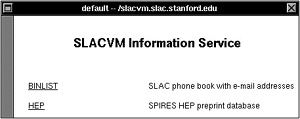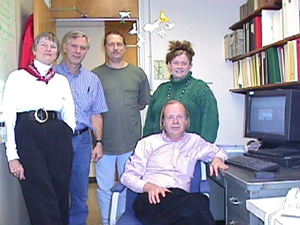
Handy Links
SLAC News Center
SLAC Today
- Subscribe
- Archives: Feb 2006-May 20, 2011
- Archives: May 23, 2011 and later
- Submit Feedback or Story Ideas
- About SLAC Today
SLAC News
Lab News
- Interactions
- Lightsources.org
- ILC NewsLine
- Int'l Science Grid This Week
- Fermilab Today
- Berkeley Lab News
- @brookhaven TODAY
- DOE Pulse
- CERN Courier
- DESY inForm
- US / LHC
SLAC Links
- Emergency
- Safety
- Policy Repository
- Site Entry Form

- Site Maps
- M & O Review
- Computing Status & Calendar
- SLAC Colloquium
- SLACspeak
- SLACspace
- SLAC Logo
- Café Menu
- Flea Market
- Web E-mail
- Marguerite Shuttle
- Discount Commuter Passes
-
Award Reporting Form
- SPIRES
- SciDoc
- Activity Groups
- Library
Stanford
Around the Bay
Happy Birthday, Dear Web
Twenty years ago this month, the World Wide Web was born. In March 1989, CERN scientist Tim Berners-Lee wrote a proposal for a "large hypertext database with typed links." It wasn't for another 33 months, however, that this Web would reach outside the European physics laboratory CERN. When it did, it stretched straight to SLAC.
In December of 1991, SLAC physicist Paul Kunz traveled to CERN on a business trip and, while he was there, met with Berners-Lee. The two discussed the fledgling Web, which at the time consisted of little more than a few pages describing the project and a Web version of the CERN telephone directory. But Kunz, like Berners-Lee, saw an opportunity.
Kunz brought the idea of the Web straight to SLAC Associate Head Librarian Louise Addis. Together they made plans to add the Stanford Public Information Retrieval System High Energy Physics database to the Web. The SPIRES-HEP database offers access to preprints of high-energy physics papers and is a long-time project of the SLAC and DESY libraries, with the collaboration of Fermilab, CERN, KEK, Durham, Lawrence Berkeley National Laboratory and others. At the time, it contained about 200,000 references to high-energy physics papers, and was searchable by authors (sometimes as many as 1200 on a single paper), institutions, titles, report numbers and keywords. With the high-energy physics community working in large groups spread all around the world, it was important to make the HEP preprint information as widely accessible as possible.
"When we first developed SPIRES-HEP, it worked only locally on terminals at SLAC," Addis said. "Then, through some cleverness of people like [Database Systems Developer] George Crane, we made long distance searches possible on BITNET via something much like today's text messaging and e-mailing. Finally, along came the Web."
Working with Computer Scientist Terry Hung and SPIRES guru Crane, Addis and Kunz put SPIRES-HEP online, installing it on the first Web server outside Europe. Like CERN, SLAC also posted the laboratory phone directory to the Web to allow easy access from off site. (The first SLAC Web pages are still online.)
After SPIRES' Web debut, a group of SLACers called the Web Wizards formed to help maintain and advance both the SPIRES-HEP online database and the Web as a whole.
"SPIRES was very, very basic compared to what we have now," said Bebo White, who worked at SLAC as a software developer and spent a fair bit of time "just keeping the darn thing from crashing."
Working alongside White were Web Wizards Mark Barnett, Les Cottrell, Tony Johnson, Joan Winters, Crane, Kunz and Addis. As Crane and Addis led the effort to make the SPIRES-HEP user interface easy to use, Johnson created the first dynamic Web pages. Unlike static pages, which are written ahead of time, dynamic pages are created automatically in response to a user-submitted query. Johnson also wrote one of the first Web browsers, Midas, which displayed both the full text of preprints and imbedded pictures. Previously users had to run programs outside of the browser to view full preprint text and diagrams.
"The Wizards inspired people to think of the Web differently, and the interface to SPIRES was one of the first 'killer apps' to the Web," said White. "It attracted attention."
Since those very early days, SLAC has remained a strong presence on the Web, helping to establish the first Web site in China, increase network speeds around the world, and continuing to run and evolve SPIRES-HEP.
"At SLAC we were lucky to have a group of adventurous people in computing," Addis said. "And just look at how far things have come since then!"
More information about SLAC's involvement in the early Web can be found on the Archives and History Office's Chronology of the Early Web at SLAC and in a CNET interview with Paul Kunz.
—Kelen Tuttle
SLAC Today, March 13, 2009

